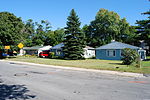Buckingham Lake

Buckingham Lake, commonly referred to as Buckingham Pond or Rafts Pond, is a body of water located in a residential area of Albany, New York. It has a surface area of 5 acres (20,000 m2) and a mean depth of three feet. The lake is adjacent to Buckingham Lake Park, a small recreation area with picnic tables and playground equipment. Three fountains help aerate water during the warmer months, while ice-skating often takes place on the lake's frozen surface during the winter. Wildlife at the lake includes ducks, Canada geese and red-winged blackbirds. The lake is surrounded by a gravel path that is a few feet wide. Streets that border the lake include Berkshire Boulevard, Euclid Avenue, Lenox Avenue, and Colonial Avenue.
Excerpt from the Wikipedia article Buckingham Lake (License: CC BY-SA 3.0, Authors, Images).Buckingham Lake
Berkshire Boulevard, City of Albany
Geographical coordinates (GPS) Address Nearby Places Show on map
Geographical coordinates (GPS)
| Latitude | Longitude |
|---|---|
| N 42.6632 ° | E -73.8063 ° |
Address
Berkshire Boulevard 30
12208 City of Albany
New York, United States
Open on Google Maps



